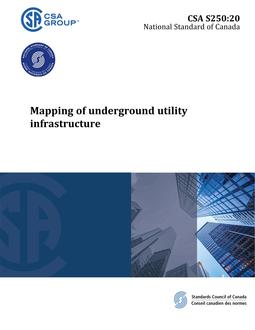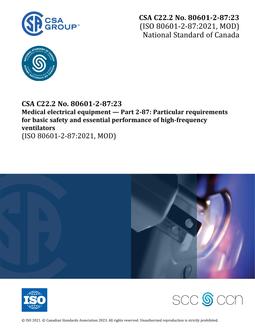
CSA S250:20
Click here to purchase
Preface:
This is the second edition of CSA S250, Mapping of underground utility infrastructure. It supersedes the previous edition published in 2011.
The following are the major changes to this edition:
- recognized field data collection technologies have been expanded to include LiDAR, total station survey (TSS), and video recordings (for supplemental records);
- the requirement for mapping records has been expanded to include all stages of operational status, which include abandoned in-place, in-service, out-of-service, and proposed;
- minor changes have been made to the requirements for record retention;
- accountabilities and responsibilities of the locator and excavator have been revised to better align with CAN/CSA-Z247;
- the records lifecycle obligation has been upgraded to be mandatory during all phases of the lifecycle of underground utility infrastructure;
- directions on the limitations of digital base mapping has been provided, as well as obligations towards its use;
- clarification has been provided in Clause 5 on how information is collected and used to depict the location and attributes of utility infrastructure so users can be confident of its level of reliability and accuracy;
- the owner’s responsibility for measuring and recording the location of underground utility infrastructures has been revised;
- the requirements for absolute spatial positioning (i.e., horizontal and vertical datums) have been revised;
- the accuracy requirements for as-builts have been streamlined in Table 1 (see Clauses 5.5 and 5.6.2 and Figures 2 to 6) and Table 2 (see Clause 5.7 and Figures 2 to 6);
- the measurement requirement has been revised to include the lowest point below grade for vertical structures (i.e., the bottom of the utility pole);
- the obligation to identify third-party data sources has been expanded within the title block of shared maps and drawings;
- the material abbreviations have been revised to better align with other industry standards; ? the specific utility infrastructure requirements and graphical representations for mapping records have been revised;
- Clause A.4.5.4.2.2 has been expanded to provide guidance on leveraging the resolution of mapping discrepancies to drive the improvement of mapping records; and
- Clause A.4.7.5 has been revised to recognize the importance of open data standards that enable data sharing between industry partners and their respective software environments.
This Standard has been developed in compliance with Standards Council of Canada requirements for National Standards of Canada. It has been published as a National Standard of Canada by CSA Group.
Scope:
1.1 General
This Standard specifies mapping requirements for the recording and depiction of underground utility infrastructure and related appurtenances at or below grade. This Standard does not apply to utility infrastructure that is normally above grade (e.g., overhead wires, pole-mounted transformers, antennas, and dishes).
1.2 Application
This Standard applies to proposed, existing, abandoned in-place, retired, or reserved for future use underground utility infrastructure.
This Standard applies to the generation, storage, distribution, and use of mapping records to ensure that underground utilities are readily identifiable and locatable. Application of this Standard will help capture accurate information about the location and nature of the underground utility infrastructure and make this information available for future projects.
1.3 Terminology
In this Standard, “shall” is used to express a requirement, i.e., a provision that the user is obliged to satisfy in order to comply with the Standard; “should” is used to express a recommendation or that which is advised but not required; and “may” is used to express an option or that which is permissible within the limits of the Standard. Notes accompanying clauses do not include requirements or alternative requirements; the purpose of a note accompanying a clause is to separate from the text explanatory or informative material. Notes to tables and figures are considered part of the table or figure and may be written as requirements. Annexes are designated normative (mandatory) or informative (non-mandatory) to define their application.
Product Details
- Edition:
- 2nd
- Published:
- 06/01/2020
- ISBN(s):
- 9781488327742
- Number of Pages:
- 83
- File Size:
- 1 file , 3.4 MB
- Product Code(s):
- 2427902, 2427902


